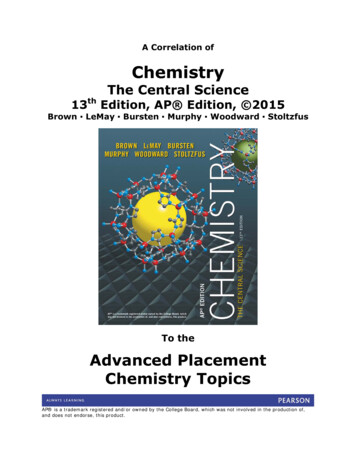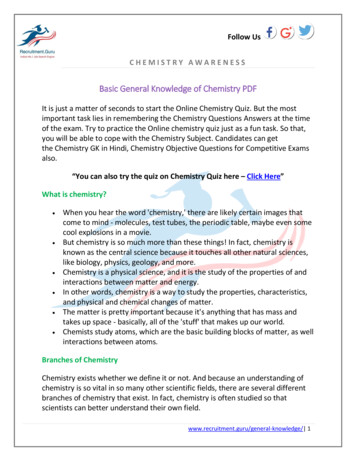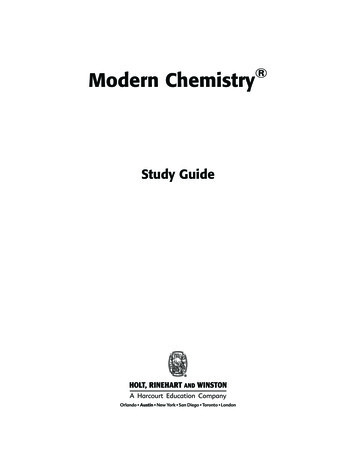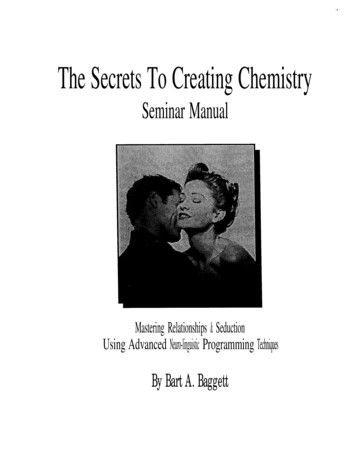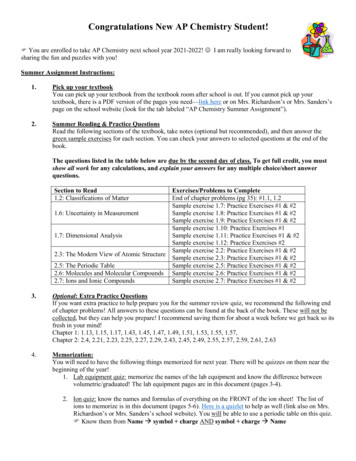
Transcription
Congratulations New AP Chemistry Student! You are enrolled to take AP Chemistry next school year 2021-2022! I am really looking forward tosharing the fun and puzzles with you!Summer Assignment Instructions:1.Pick up your textbookYou can pick up your textbook from the textbook room after school is out. If you cannot pick up yourtextbook, there is a PDF version of the pages you need—link here or on Mrs. Richardson’s or Mrs. Sanders’spage on the school website (look for the tab labeled “AP Chemistry Summer Assignment”).2.Summer Reading & Practice QuestionsRead the following sections of the textbook, take notes (optional but recommended), and then answer thegreen sample exercises for each section. You can check your answers to selected questions at the end of thebook.The questions listed in the table below are due by the second day of class. To get full credit, you mustshow all work for any calculations, and explain your answers for any multiple choice/short answerquestions.Section to Read1.2: Classifications of Matter1.6: Uncertainty in Measurement1.7: Dimensional Analysis2.3: The Modern View of Atomic Structure2.5: The Periodic Table2.6: Molecules and Molecular Compounds2.7: Ions and Ionic CompoundsExercises/Problems to CompleteEnd of chapter problems (pg 35): #1.1, 1.2Sample exercise 1.7: Practice Exercises #1 & #2Sample exercise 1.8: Practice Exercises #1 & #2Sample exercise 1.9: Practice Exercises #1 & #2Sample exercise 1.10: Practice Exercises #1Sample exercise 1.11: Practice Exercises #1 & #2Sample exercise 1.12: Practice Exercises #2Sample exercise 2.2: Practice Exercises #1 & #2Sample exercise 2.3: Practice Exercises #1 & #2Sample exercise 2.5: Practice Exercises #1 & #2Sample exercise 2.6: Practice Exercises #1 & #2Sample exercise 2.7: Practice Exercises #1 & #23.Optional: Extra Practice QuestionsIf you want extra practice to help prepare you for the summer review quiz, we recommend the following endof chapter problems! All answers to these questions can be found at the back of the book. These will not becollected, but they can help you prepare! I recommend saving them for about a week before we get back so itsfresh in your mind!Chapter 1: 1.13, 1.15, 1.17, 1.43, 1.45, 1.47, 1.49, 1.51, 1.53, 1.55, 1.57,Chapter 2: 2.4, 2.21, 2.23, 2.25, 2.27, 2.29, 2.43, 2.45, 2.49, 2.55, 2.57, 2.59, 2.61, 2.634.Memorization:You will need to have the following things memorized for next year. There will be quizzes on them near thebeginning of the year!1. Lab equipment quiz: memorize the names of the lab equipment and know the difference betweenvolumetric/graduated! The lab equipment pages are in this document (pages 3-4).2. Ion quiz: know the names and formulas of everything on the FRONT of the ion sheet! The list ofions to memorize is in this document (pages 5-6). Here is a quizlet to help as well (link also on Mrs.Richardson’s or Mrs. Sanders’s school website). You will be able to use a periodic table on this quiz. Know them from Name symbol charge AND symbol charge Name
Other Reminders/Helpful Info:1. Quizzes:We will have 3 beginning of the year quizzes. They will be during week 2-3.1. Summer Review Quiz: covers everything from the review slides, as well as metric prefixes you mustknow!2. Lab equipment quiz: memorize the names of the lab equipment and know the difference betweenvolumetric/graduated!3. Ion quiz: know the names and formulas of everything on the FRONT (first page) of the ion sheet! Know them from Name symbol charge AND symbol charge Name2. Required Materials for AP Chem:a. Scientific OR graphing calculator—everyone will need one!b. Textbook—these will be disturbed next school year, you won’t need them for the summer assignment.3. Optional Materials for AP Chem:c. Review Book: If you would like to purchase an AP review book, Mrs. Richardson recommends either ThePrinceton Review for AP Chemistry (has best practice problems) or Crash Course by Adrian Dingle (hasbest overview of material).d. For Mrs. Sander’s class, you can choose to purchase a lab notebook (not required, and Mrs. Richardson’sclass does not use a lab notebook.)Suggestion: 100 pg spiralbound ¼” grid carbonless copy lab notebookBy Barbakam or currently 16 online at Barnes and NobleNOTE: For all ONLINE reference sheets please check Mrs. Richardson’s or Mrs. Sanders’s website over thesummer. If you have questions, please email Mrs. Richardson (richardsonj@luhsd.net) or Mrs. Sanders(sandersm@luhsd.net).Have a wonderful summer and see you in a few months!!Sincerely,Mrs. Mindy SandersMrs. Jennifer Richardson
Assorted Lab EquipmentWash BottleRing SupportTest Tube Rack**You areresponsible forknowing ALL ofthese EXCEPT theCeramic Squareand the Condenser.Those are unlikelyto be used this yearin AP chemistry.
Lab Equipment Reference SheetGlassware: Reaction VesselsThe following pieces of glassware are for reactions—they are not intended for measuring accurate quantities!Glassware: Measuring Volumes of LiquidsThere are two types of glassware that are intended for measurement.The first type is graduated glassware—this type has graduations, orsmall markings on the side, to indicate different volumes. Notice howthey are all long and narrow—this is to make them more accurate intheir measurements!The second type of glassware for measurement is volumetric glassware. This type only measures one volume!This means that it only has one line to indicate a volume. They are extremely precise, so they are good formeasuring accurate volumes and making solutions.
AP Chemistry Ions to KnowThe FRONT of this paper has ions you MUST KNOW (memorize them)! The back of this paper is a referencesheet—these are handy to know, but you won’t be expected to memorize them.Part 1: Monatomic IonsMonatomic ions are ions made of a single atom(mono one, atomic atom). You can determine thecharge of most main group elements by their locationon the periodic table.To Name Monatomic Ions:Cations (positive) “element name” “ion”Ex: Hydrogen ion H 1Ex: Magnesium ion Mg2 Anions (negative) “element name” “-ide” “ion”Ex: Fluoride ion F-1Ex: Oxide ion O-2You must know the names and charges of all the monatomic ions shown on the periodic table above.Part 2: Monatomic Ions with Multiple ChargesTransition metals and some other monatomic ions can have more than one possible charge. This only happenswith cations. To name them, we either use a roman numeral indicating their charge (new system), or we use an ous or -ic ending (old system). Hint: “-ous” is always the lower charge and “-ic” is always the higher charge!The ones listed below are most useful, but there is a full list on the back of this sheet!Ion SymbolFe2 Fe3 Cu1 Cu2 Pb2 Pb4 Ion Name (New System)Iron (II) ionIron (III) ionCopper (I) ionCopper (II) ionLead (II) ionLead (IV) ionIon Name (Old System)Ferrous ionFerric ionCuprous ionCupric IonPlumbous ionPlumbic ionPart 3: Polyatomic ionsPolyatomic ions are groups of covalently bonded atoms that collectively have a positive or negative charge. Thelist below has the most common ones, which are the most important to memorize.You must eCarbonateBicarbonateCyanideFormula name formulaNH4OHNO3NO2CH3COOH- orC2H3O2CO32HCO3CN-ANDformula NH2SO42SO32PO43H3O
Complete Ion List: For Reference Only!You only need to memorize the FRONT of this paper, not this side.CATIONSANIONS2 ManganousMnManganicMn3 MercurousHg22 MercuricHg2 FerrousFe2 FerricFe3 Ions withCuprousCu1 MultipleCupricCu2 ChargesStannousSn2 StannicSn4 ChromousCr2 ChromicCr3 PlumbousPb 2PlumbicPb 4PermanganateMnO4ManganateMnO3AmmoniumNH4 HydroxideOHHydroniumH3O Hydroxide with DeuteriumODNitrateNO3NitriteNO2AcetateCH3COO- or C2H3O2BicarbonateHCO3MonovalentPeriodateIO4( 1/-1)IodateIO3Polyatomic OBisulfiteHSO3CyanideCNAmideNH2Dihydrogen phosphateH2PO42ChromateCrO4DichromateCr2O7 2OxalateC2O42SulfateSO42Divalent ( 2/-2)Polyatomic n phosphateHPO42Trivalent ( 3/-3)PhosphatePO43Polyatomic Ions
textbook, there is a PDF version of the pages you need—link here or on Mrs. Richardson’s or Mrs. Sanders’s page on the school website (look for the tab labeled “AP Chemistry Summer Assignment”). 2. Summer Reading & Practice Questions Read the following sections of the textbook, t




